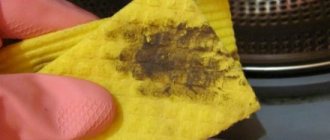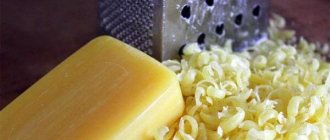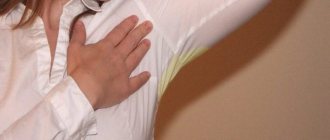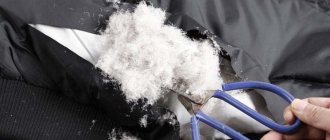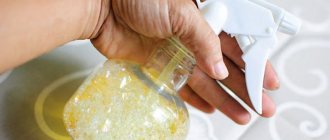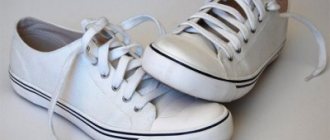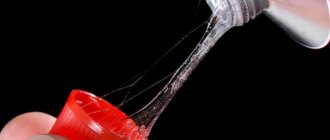Soap and vinegar
This is a very simple method that is suitable even for colored items. Don't be afraid, in small concentrations, vinegar is not at all dangerous. It's even used to set color!
How to use:
Add grated soap and a few tablespoons of vinegar to a bowl of warm water. Wash the fabric in this water and then rinse under running water. The smell can be removed with conditioner.
Note:
If you don’t have vinegar on hand, use a few tablespoons of soda. But it must be well dissolved. We recommend using laundry soap, but regular soap will work too.
Photo: shkolagolova.ru
We erase the yellowness
Yellowness appears on clothes for a number of reasons, firstly, from poor washing, and secondly, from sweat. It can also be caused by lying in a closet for a long time. Don't rush to run to the dry cleaner and waste money or throw away the item. It can be returned to its original appearance, the main thing is to know how to properly remove such stains.
Next, let's look at each method in more detail:
- The yellowness disappears well when boiled. Just remember the main rule: this method is only suitable for cotton. So, we need: an enamel pan or bucket of at least five liters, powder, vegetable oil, soda, stain remover.
Fill the container one third with water and place on fire. While the water is heating up, add three large spoons of oil, 150 grams of powder, ideally if it has a whitening effect (that is, it must contain active ingredients), 100 grams of table soda.Mix everything thoroughly, after boiling, reduce the heat and immerse the shirt in it. The duration of digestion should be from forty minutes to an hour. Remember to stir the laundry periodically, otherwise the cleaning may be uneven.
- If you decide to boil, but do not trust the method described above, you can easily replace the components. For example, some do this exclusively using powder or bleach. And children's things are cleaned using soda or laundry soap.
- Stain remover, it must first be applied to the problem area in its pure form and left for 20-30 minutes. And then add it to the machine when washing. In most cases, the yellow color goes away after one wash cycle.
- Hydrogen peroxide is an excellent product that can whiten and remove most stains. Apply peroxide to the problem area using a sponge and leave for ten to fifteen minutes.
If the mark is still quite intense, extend the exposure time by another ten minutes. Then, in order for the color to be fairly uniform throughout the entire product, you need to pour warm liquid into the basin, its quantity depends on the volume of the product. Then you need to add peroxide at the rate of 100 ml per two liters of water.Soak the men's shirt for a couple of hours. Afterwards you need to wash it in the washing machine. Just remember that peroxide is a rather aggressive component, and it is prohibited to use it every time you wash. Otherwise, the thing is simply destroyed.
- Gasoline plus ammonia solution. This method can cope with complex and neglected stains. The first thing you need to do is soak a sponge in gasoline and apply it to the stain, rubbing lightly. We recommend covering everything along the contour with salt, as if to salt the stain. If this is not done, it may spread.
Next, you will have to treat the same area with ammonia. Well, then you need to put everything in the wash. These components have a rather strong aroma and most likely you will not be able to remove it the first time. To speed up this process, it is recommended to hang your laundry in the fresh air.
- Vinegar. This product is quite aggressive and therefore we do not recommend resorting to this method without unnecessary need. You will need to treat the stains with acetic acid diluted with water in a one to one ratio. Leave for a quarter of an hour and rinse. For use on cotton only.
Ammonia
Another fairly well-known and widespread option among people.
How to use:
Dissolve 1 tsp. ammonia in two glasses of warm water. Wet the stain well with the mixture, leave for 5 minutes and wash.
Note:
This method works well for blue stains on white fabric, but for colored items, look for a more delicate method!
How to clean a silver chain at home: 10 effective ways
Features of yellow and brown stains on panties from urine, feces and sweat
Panties, as the most necessary and at the same time difficult to care for item of clothing, need to be changed daily. Washing underwear that comes into contact with the most delicate areas of the body is a responsible process. Improper care will only further strengthen traces of discharge in the tissue structure.
Why are they so difficult to wash off?
- When contacted with traces of sweat, many industrial cleaners cause a chemical reaction that only makes the stains more permanent. Fats and lipids cause unpleasant odors and difficult to remove marks on textiles.
- An old urine stain that has not been washed for a long time or has been done incorrectly acquires a layer of salt, making it practically invulnerable to ordinary powder.
- If you do not immediately wash an item stained with feces, then removing the yellow stain, which has penetrated deeply into the structure of the textile, will be very difficult. Biological traces are always difficult to wash off, let alone human excrement, which also leaves an unpleasant odor on the laundry.
There is no point in talking about the nature of the appearance of spots, because it is already obvious. But depending on the type of pollution, a means to combat it is selected.
What not to use and do
- Linen with signs of menstruation should not be cleaned in hot water. The blood will immediately clot.
- Chlorine-based bleaches, brighteners and laundry additives are harmful to fabrics and make stains more permanent.
- Washing different types of laundry at the same time can cause deformation and breaks in the fibers.
- You cannot turn on a strong spin using an automatic machine.
- Mixing different colored items during wet cleaning can cause dyes to shed.
- Strong hand-wringing, washing at high water temperatures, and machine drying/ironing are contraindicated for panties, especially women's panties. The latter often have fragile jewelry that can “survive” only manual care without harm.
Rinse aid for colored items
Use a delicate method for multi-colored and black clothes. Just take a special mouthwash!
How to use:
Pour a cap of rinse aid into the basin, soak the clothes for 10 minutes and wash. At the end, be sure to rinse everything in clean water. Amounts may vary, so follow your detergent's instructions.
Note:
You can rinse things not by hand, but in a machine on a short cycle at 30 degrees.
How to clean a carpet at home?
Removing greasy stains
How to clean a shirt collar from stains is quite simple, the main thing is to choose the right products. The most problematic area is the inside of the collar and cuff, since the greatest friction with the body occurs there, and it is known to produce fat and sweat during the day, which protect our epidermis from environmental influences.
The following home remedies will help you:
- Anti-stain soap, treat stained areas with it, especially carefully soap the sealing strip on the collar and cuffs. Then use a brush to lather and leave for an hour, after the time has passed, rinse and put into the machine.
- Digestion. But if the dirt is very strong, pre-treat with laundry soap. We recommend using baking soda and washing powder as active ingredients.
- Stain remover, for example Vanish, Swan, Boss. The packaging contains detailed instructions for each product. The main thing is to follow the manufacturer's recommendations.
To avoid such severe contamination, it is recommended to wash shirts daily, especially light ones, or at least once every two days. Because dirt greatly reduces the lifespan of clothing.
Lemon acid
Unlike vinegar, acid also smells nice, so you don't have to wash the smell out!
How to use:
Dissolve 1 tsp in a glass of hot water. acid and soak a cotton pad in the liquid. Apply to the stain for 10-15 seconds and gently wipe off so as not to damage the fabric. Rinse the area with running water.
Note:
Instead of citric acid, you can take oxalic acid. It’s much less common, but suddenly you just happen to have it lying around.
Photo: big-stirka.ru
Removing traces of cosmetics
Almost every woman knows such troubles: traces of foundation on a collar or cuff. But, unfortunately, not everyone knows how to effectively deal with them.
Here is a list of the most effective means:
- Laundry soap. Lather the problem area with soap, rub a little and rinse with warm water. If necessary, the procedure can be repeated.
- Antipyatin. Apply the product to the problem area, wait a few minutes, rub and rinse.
- Dish degreasing agent perfectly removes traces of foundation. It is enough to apply a small amount of product to the problem area and then rinse off. Next, wash as usual.
- Hydrogen peroxide. Soak a cotton pad with peroxide and apply it to the contaminated area. If after the first time the cosmetics are not completely washed off, repeat the procedure.
- Shampoo. Pour some shampoo onto the brush and scrub the dirty area. Rinse off with warm liquid.
Stain remover stick
They are sold anywhere: from underground passages and transport to supermarkets. If you usually pass by, it’s in vain. The product is truly working and versatile!
How to use:
Just use the pencil according to the instructions. Usually you need to rub it on the problem area, wait 10-15 minutes and rinse.
Note:
For white things there are the same bleaches in pencils.
How to clean an iron from burning at home?
FABRIC COMPOSITION MATTERS
Incorrect processing and non-compliance with temperature conditions can damage the fabric more than the stain itself, so always read the care label for your product. If there is no label, use these general guidelines.
1. Shirts, which are predominantly cotton, are considered heat-resistant and can be washed in a washing machine. For pre-treatment, you can use mild acids, such as lemon juice or vinegar.
2. Synthetic fabrics are more tolerant of mechanical stress - they will withstand washing, but at the same time they are more sensitive to bleaching agents. Here it is safer to use regular washing powder to get rid of the stain.
Things to consider before removing stains
Origin of the stain.
The cleaner is selected for a specific type of stain. That's why professional stain removers have products for different stains: for example, Dr. Beckmann produces separate products for ballpoint pen and felt-tip pen stains, glue, blood and protein stains. If you choose the wrong cleaner, it will not dissolve the stain.
This is important to consider when choosing a washing method. For example, fat is easier to wash off with hot water, and blood is easier to wash off with cold water.
Type of fabric.
Need to consider:
- Composition of the material. The most difficult stains to remove are from delicate fabrics: satin, velvet, wool, silk, fine synthetics. They do not tolerate aggressive household chemicals and friction. Nylon or silk acetate may dissolve along with the stain after applying acetone or solvent. Natural fabrics are less picky about the composition of the cleaner due to their loose structure, but they absorb dirt more strongly, so they are difficult to wash the first time.
- Color. White clothes can be washed with almost any stain remover without worrying about discolouration. But to treat colored fabrics, you cannot use hydrogen peroxide, chlorine-containing products, solvents and citric acid.
General rules.
If you have a stain, read the recommendations before washing:
- Check the tag. On the label, manufacturers indicate recommendations for care - washing and drying.
- If you are not sure about the effect of the product, test it on a small piece of cloth. A sample attached to a tag will do.
- Immediately blot fresh stains with a dry cloth and cover with salt or starch so that the marks do not spread.
- If possible, wash your clothes as quickly as possible. But try not to rub the fabric too much so that there are no pellets left on it.
- It is better to take clothes made from delicate fabrics to the dry cleaner immediately. Experimenting with folk remedies and aggressive compounds can ruin the color or structure of the fabric.
